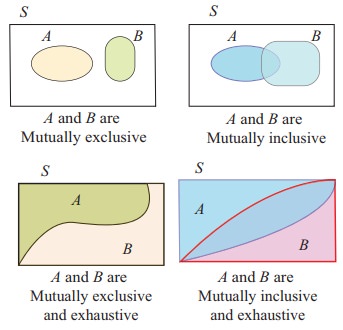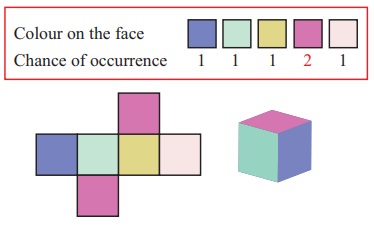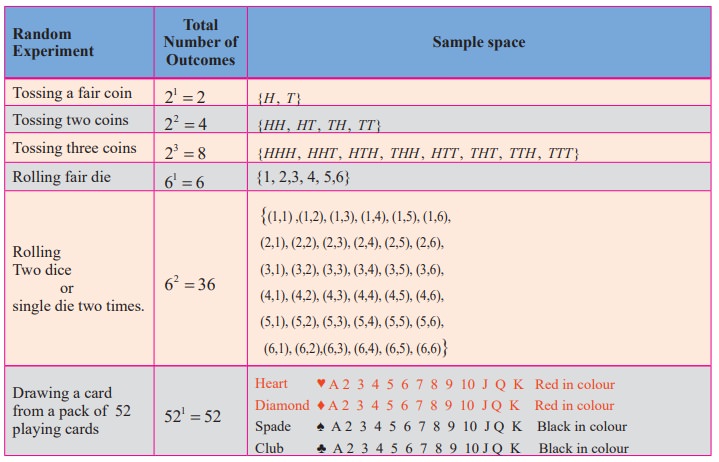Definition - Finite sample space - Probability Theory | 11th Mathematics : UNIT 12 : Introduction to Probability Theory
Chapter: 11th Mathematics : UNIT 12 : Introduction to Probability Theory
Finite sample space - Probability Theory
Finite sample space
In this section we restrict our sample spaces that have at most a finite number of points.
Types of events
Let us now define some of the important types of events, which are used frequently in this chapter.
ŌĆó Sure event or certain event
ŌĆó Complementary event
ŌĆó Mutually inclusive event
ŌĆó Equally likely events
ŌĆó Impossible event
ŌĆó Impossible event
ŌĆó Mutually exclusive events
ŌĆó Exhaustive events
ŌĆó Independent events (defined after learning the concepts of probability)
Definition 12.6
When the sample space is finite, any subset of the sample space is an event. That is, all elements of the power set P ( S )of the sample space are defined as events. An event is a collection of sample points or elementary events.
The sample space S is called sure event or certain event. The null set Ōłģ in S is called an impossible event.
Definition 12.7
For every event A, there corresponds another event ![]() is called the complementary event to A. It is also called the event ŌĆśnot AŌĆÖ.
is called the complementary event to A. It is also called the event ŌĆśnot AŌĆÖ.
Illustration 12.2
Suppose a sample space S is given by S = {1,2,3,4}.
Let the set of all possible subsets of S (the power set of S) be P ( S).
P (S) = {Ōłģ, {1}, {2}, {3}, {4}, {1, 2}, {1, 3}, {1, 4}, {2, 3}, {2, 4}, {3, 4},{1, 2, 3}, {1, 2, 4}, {1, 3, 4}, {2, 3, 4}, {1, 2, 3, 4}}
(i) All the elements of P ( S ) are events.
(ii) Ōłģ is an impossible event.
(iii) {1},{2},{3},{4} are the simple events or elementary events.
(iv) {1, 2, 3, 4}is a sure event or certain event.
Definition 12.8
Two events cannot occur simultaneously are mutually exclusive events. A1 , A2 , A3 ,..., Ak are mutually exclusive or disjoint events means that, Ai Ōł® Aj = Ōłģ , for i ŌēĀj.
Definition 12.9
Two events are mutually inclusive when they can both occur simultaneously.
A1 , A2 , A3 ,..., Ak are mutually inclusive means that, Ai Ōł® Aj ŌēĀ Ōłģ , for i ŌēĀ j
Illustration 12.3
When we roll a die, the sample space S = {1,2,3,4,5,6}.
(i) Since{1, 3}Ōł® {2, 4, 5, 6}=Ōłģ, the events {1,3}and{2, 4,5,6}are mutually exclusive events.
(ii) The events {1,6,},{2,3,5} are mutually exclusive.
(iii) The events {2,3,5},{5,6} are mutually inclusive, since {2, 3, 5}Ōł® {5, 6}={5} ŌēĀ Ōłģ
Definition 12.10
A1 , A2 , A3 ,..., Ak are called exhaustive events if, A1 Ōł¬ A2 Ōł¬ A3 Ōł¬ .... Ōł¬ Ak = S
Definition 12.11
A1 , A2 , A3 ,..., Ak are called mutually exclusive and exhaustive events if,
(i) AiŌł® Aj ŌēĀŌłģ , for i ŌēĀ j
(ii) A1 Ōł¬ A2 Ōł¬ A3 Ōł¬ ........ Ōł¬ Ak = S
Illustration 12.4
When a die is rolled, sample space S = {1,2,3,4,5,6}.
Some of the events are {2,3},{1,3,5},{4,6},{6} and{1,5}.
(i) Since {2, 3}Ōł¬ {1, 3, 5}Ōł¬{4, 6} = {1, 2, 3, 4, 5, 6} = S (sample space), the events {2,3},{1,3,5},{4,6} are exhaustive events.
(ii) Similarly {2,3},{4,6}and{1,5} are also exhaustive events.
(iii) {1,3,5},{4,6},{6} and{1,5} are not exhaustive events.
(Since {1, 3, 5}Ōł¬ {4, 6}Ōł¬ {6}Ōł¬ {1, 5} ŌēĀ S)
(iv){2,3},{4,6},and{1,5} are mutually exclusive and exhaustive events, since
{2,3}Ōł®{4, 6} = Ōłģ, {2, 3}Ōł®{1, 5}= Ōłģ,{4, 6}Ōł®{1, 5} = Ōłģ and {2, 3}Ōł¬ {4, 6}Ōł¬ {1, 5} = S
Types of events associated with sample space are easy to visualize in terms of Venn diagrams, as illustrated below.

Definition 12.12
The events having the same chance of occurrences are called equally likely events.
Example for equally likely events: Suppose a fair die is rolled.

Example for not equally likely events: A colour die is shown in figure is rolled.

Similarly, suppose if we toss a coin, the events of getting a head or a tail are equally likely.
Methods to find sample space
Illustration 12.5
Two coins are tossed, the sample space is
(i) S = {H ,T }├Ś {H ,T } = {(H , H ),(H ,T ),(T , H ),(T ,T )} or {HH , HT ,TH ,TT}
(ii) If a coin is tossed and a die is rolled simultaneously, then the sample space is
S= {H ,T}├Ś{1,2,3,4,5,6} = {H 1, H 2, H 3, H 4, H 5, H 6,T 1,T 2,T 3,T 4,T 5,T 6} or
S= {(H ,1),(H ,2),(H ,3),(H ,4),(H ,5),(H ,6),(T ,1),(T ,2),(T ,3),(T ,4),(T ,5),(T ,6)}.
Also one can interchange the order of outcomes of coin and die. The following table gives the sample spaces for some random experiments.

Notations
Let A and B be two events.
(i) A Ōł¬ B stands for the occurrence of A or B or both.
(ii) A Ōł® B stands for the simultaneous occurrence of A and B. A Ōł® B can also be written as AB
(iii) ![]() or AŌĆ▓ or Ac stands for non-occurrence of A
or AŌĆ▓ or Ac stands for non-occurrence of A
(iv) A Ōł® ![]() stands for the occurrence of only A.
stands for the occurrence of only A.
Related Topics